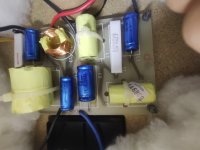Fulfilling such a request would require access to either an annotated crossover schematic or photos of the crossover board that clearly show the markings on all its capacitors.
@Galu
The values on the caps are as follows per zone location which is printed on the crossover board. All caps have a value printed on them "50 vnp"
They are all 32mm in length.
C1: 8MFD
C2: 20MFD
C3: 4.2MFD
C4: 45MFD
The make/type is Alcap.
I'm not sure if Alcap is an nold make but they certainly don't look "old" to me and are younger looking that the eCaps I took of the Lintons.
Here's a pic as well.
The values on the caps are as follows per zone location which is printed on the crossover board. All caps have a value printed on them "50 vnp"
They are all 32mm in length.
C1: 8MFD
C2: 20MFD
C3: 4.2MFD
C4: 45MFD
The make/type is Alcap.
I'm not sure if Alcap is an nold make but they certainly don't look "old" to me and are younger looking that the eCaps I took of the Lintons.
Here's a pic as well.
Attachments
Alcaps are reliable capacitors and are likely to have remained within spec.
I have early 80s speakers containing Alcaps that I've been happy to leave in situ.
If you really want to refresh them, Falcon Acoustics stock the following Alcap values that would work as replacements:
C1: 8 uF; C2: 20 uF; C3: 4.7 uF; C4: 50 uF
https://www.falconacoustics.co.uk/ls35a-kit-falcon-minimonitor-q7-systems.html?p=12
P.S. "50 VNP" means "50 V Non Polar". Crossover caps must be Non Polar (NP). A higher voltage rating is quite permissible.
I have early 80s speakers containing Alcaps that I've been happy to leave in situ.
If you really want to refresh them, Falcon Acoustics stock the following Alcap values that would work as replacements:
C1: 8 uF; C2: 20 uF; C3: 4.7 uF; C4: 50 uF
https://www.falconacoustics.co.uk/ls35a-kit-falcon-minimonitor-q7-systems.html?p=12
P.S. "50 VNP" means "50 V Non Polar". Crossover caps must be Non Polar (NP). A higher voltage rating is quite permissible.
Last edited:
Thanks I'm gonna change them as it seems that there is a risk that the old caps can blow my newly purchased tweeters and I ain't going through all that again 🫣
OK. Let's close down this thread as it is simply an extension of this one:
@Galu has guided me on this re capacitors on a separate thread sorry to confuse having two similar threads rinning. I'm only looking at £20 or thereabouts to replace 4 caps per speaker from Falcon Acoustics, so worth it but here's a pic anyhow. Ta.
Apologies for the confusion..multiple threads.
I have placed the above caps, which are electrolytes, in my wish list so ready to order.
The values on two are 0.5 out from original MFD i.e. the 8 is available in 7.5 and the 4.2 is available in 4.7. but I'm assuming that is fine.
Thanks again for your valued help I am gaining so much knowledge on this.
I have placed the above caps, which are electrolytes, in my wish list so ready to order.
The values on two are 0.5 out from original MFD i.e. the 8 is available in 7.5 and the 4.2 is available in 4.7. but I'm assuming that is fine.
Thanks again for your valued help I am gaining so much knowledge on this.
the 8 is available in 7.5 and the 4.2 is available in 4.7. but I'm assuming that is fine.
If you look at your original caps you will see they have a manufacturing tolerance of plus or minus 10%, meaning that there is some leeway in choosing replacement values.
To increase your knowledge base, when you wire capacitors in parallel (side by side) their values add together.
If you wanted to get nearer to the original 45 uF than the 50 uF I suggested as a replacement, you could wire (for example) a 4.7 uF in parallel with a 40 uF.
P.S. 8 uF is available in the Alcap 100 V high power range, but perhaps it's best to have all the capacitors selected from the 50 V range as originally specified.
- Home
- Loudspeakers
- Multi-Way
- Celestion DL10 series 2 Capacitor Spec
